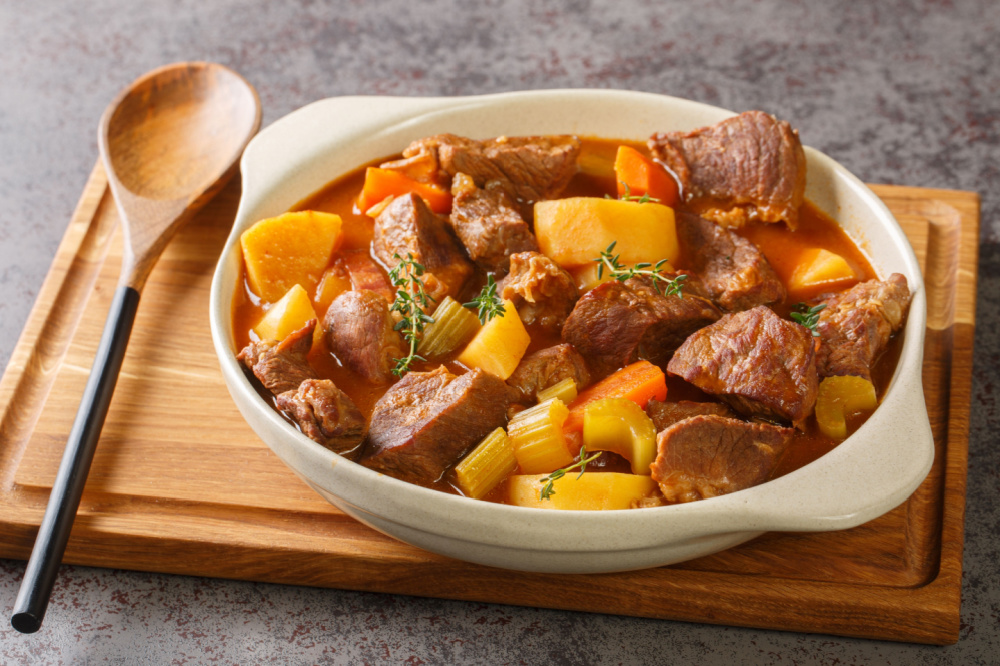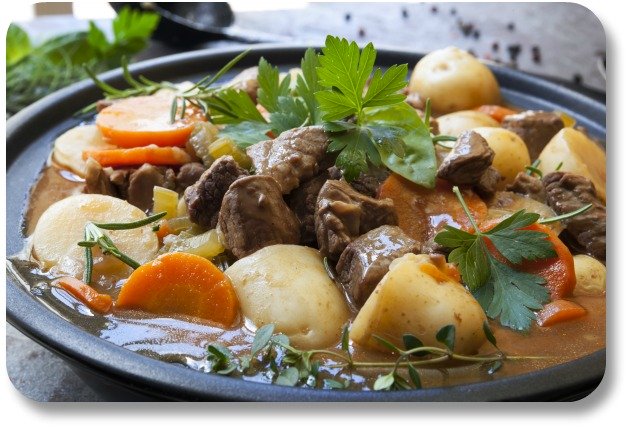- Home
- Irish Food Recipes
- Irish Stew
Irish Stew Recipe: Bringing the Classic Flavors of Ireland into Your Home
You don’t need to be in Ireland to enjoy this flavorful, traditional Irish Stew recipe. And
it doesn’t need to be St. Patrick’s Day, although it would be uniquely
appropriate for that evening meal. You can enjoy this classic Irish dish anywhere
and anytime.
We All Have a Unique and Personal "Irish Side."
Here’s some information you might find interesting, along with recipes you can use if you’re inspired to make it yourself.
What Is Irish Stew?
Some would say a traditional Irish stew recipe consists of whatever leftovers are available, but technically that’s untrue.
Irish stew is a flavorful, hearty but simple meal typically consisting of lamb, potatoes, onions and other ingredients. A bit of parsley or turnip is often tossed in.
What Makes It Uniquely Irish?
Irish stew has always been based on lamb/mutton, potato and onion. These were the ingredients that were cheap and available to Irish farmers who based their living on sheep and root crops.
Sheep have always been a big food source in Ireland, and before the Irish potato famine, potatoes were the island’s main food crop. So, this meal evolved out of the specific foods that were widely available, even to the poor.
Food was often scarce, and it was necessary to use trimmings that would otherwise be discarded (neck bones and so forth) to make the stew. If simmered long enough, the shreds of meat on these trimmings created a delicious stock.
The stock was thickened and made tastier and more filling by adding potatoes and onions. If they were available, carrots, turnips, parsnips, parsley and/or barley were tossed in for additional flavor and nutrition.
Stew is eaten in other countries, of course, but the use of lamb or mutton is what makes this type so uniquely Irish. In many other countries – such as the United States, for example – the stew meat is typically beef.

Our Favorite Irish Stew Recipes
In the old days, stew was cooked in cauldrons hung over open fires - the Irish poor didn’t have fancy stoves or ovens. Its ingredients are boiled and then simmered slowly for hours to soften and remove the meat from the stringy, tough mutton or lamb necks.
Some recipes have transformed this traditional poor-man’s dinner into something much more elaborate than ballymaloe. In fact, some recipes create such a savory delight that they almost bring this dish into the world of gourmet food - almost.
And some versions substitute a different meat for the lamb or mutton. Those versions might be delicious, but without the lamb or mutton, they’re not the traditional Irish version.
Essentially every Irish household has its own recipe, but here are three to choose from. The first creates a traditional ballymaloe for 6 and takes about 2 hours from start to finish.
Irish Stew Recipe: Ingredients
- 2 lbs. lamb (necks, chops, shoulder, etc.), cut into 2-inch chunks where possible. Substitute beef only as a last resort.
- 1 tbsp. butter Salt and pepper to taste
- 1 large onion, sliced
- 2 peeled carrots, cut into large chunks
- 3 peeled and quartered potatoes
- 4 cups water
- I cup chopped leeks
- 1 tbsp. chopped fresh parsley as garnish (optional)
Preparation
- In a large stockpot, melt butter over medium heat.
- Add lamb and cook until browned evenly.
- Add salt and pepper for seasoning.
- Add onion and carrots to the meat; cook gently for 5-10 minutes.
- Add the water, cover and bring to a boil; then simmer gently (don’t boil) for at least 1 hour, until the meat turns meltingly-tender.
- Add potatoes and simmer another 15-20 minutes, or until potatoes are fork-tender.
- Before serving, remove any bones. Serve steaming hot, garnished with parsley.
An Even Heartier Version!
- You can make this traditional Irish stew recipe even heartier.
- Begin with the same ingredients and directions as above but add 2 cups beef, chicken or lamb broth and subtract 1 cup water.
- Add 1-2 tbsp. pearl barley and toss it in at the same time as the onion and carrots.
- If you like, you can also add a sprig of thyme and some chunks of parsnip for even more flavor (the parsnip will add some sweetness).
- You could also add 1 tbsp. chopped chives to your parsley garnish. If you prefer a thicker stock, add flour while your stew is simmering.
Finally, a More Modern Twist...
Adding some Guinness stout to the broth alters this Irish stew recipe's flavor and makes it less traditional, but it certainly creates a delicious meal. If you like this idea, check out our Guinness Beef Stew recipe here.
Serve with Irish soda bread (to mop up the stew’s stock) and a pint of Guinness.
Craving an Irish Meal?
Sharing Irish food is one of our favorite ways to enjoy an Irish experience, wherever in the world we happen to be! The flavors of an Irish meal, and the stories that come along with many Irish recipes, gives us a sense of connection with the Emerald Isle.
To help feed your Irish side, we have over the years created many downloadable, share-able Irish games, puzzles, recipes, songbooks, quizzes, and much, much more.
Want them right now? Keep reading to learn about "Your Irish Expressions Playbook."
More Fun With Irish Expressions:
Your Irish Expressions Playbook
Congratulations on learning more about the Emerald Isle and discovering what we like to call your "Irish Side." You may be thinking "I'd love to actually VISIT Ireland but that's really not in the cards right now. What am I supposed to do with the stuff I just learned?"
Well never fear! Since 2007 we have collected all of the best printable, shareable resources we could find, to help you put your new knowledge of Ireland to good use. We've put them all together in a single download we call "Your Irish Expressions Playbook," which contains over 100 pages of games, puzzles, recipes, songbooks, quizzes, travel guides and much, much more.

Purchase them ALL for one small price, print as many copies as you like and share them with your friends - with no limitations! But order soon - we are already adding to the Playbook for future editions and this price will not last long.
Oh, want one more reason to order right away? If you buy YOUR copy of the Playbook now, you will be allowed to upgrade to any new future edition for FREE.
PRO TIP: Be sure to click the 'return to merchant' button following checkout, to ensure you are routed to the page where you can download your Playbook. Any issues? Just reach out to us at support@irish-expressions.com and we will make it right.

Please Share Your Feedback
Did we miss anything? Is there a topic you would like us to cover in the future? Tap HERE to let us know!


